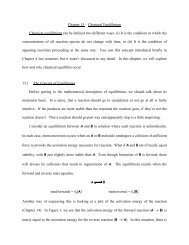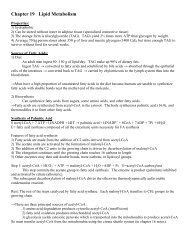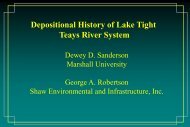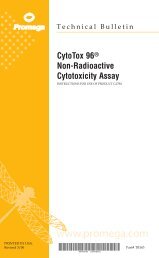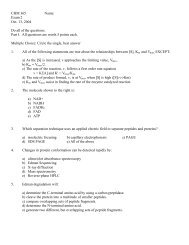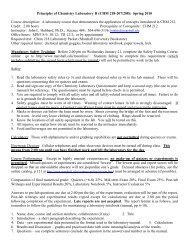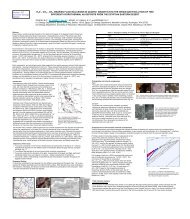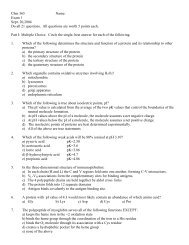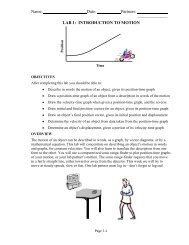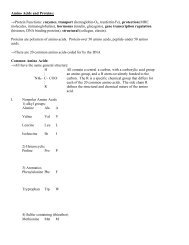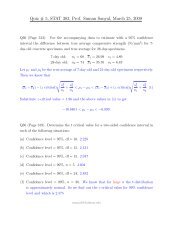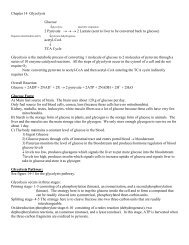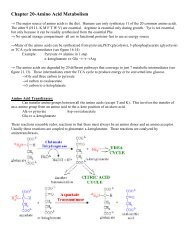Link to our lab as a pdf - College of Science - Marshall University
Link to our lab as a pdf - College of Science - Marshall University
Link to our lab as a pdf - College of Science - Marshall University
You also want an ePaper? Increase the reach of your titles
YUMPU automatically turns print PDFs into web optimized ePapers that Google loves.
PCR Technology<br />
PCR is the corners<strong>to</strong>ne <strong>of</strong> current forensic DNA analysis <strong>as</strong> well <strong>as</strong> many other biological disciplines,<br />
such <strong>as</strong> drug discovery and dise<strong>as</strong>e diagnosis. PCR w<strong>as</strong> invented in the mid-1980s by Dr. Kary Mullis,<br />
who w<strong>as</strong> awarded the Nobel Prize in Chemistry in 1993 for this revolutionary breakthrough. PCR is<br />
like a biological pho<strong>to</strong>copier. This sensitive technique is capable <strong>of</strong> producing millions, even billions<br />
<strong>of</strong> copies <strong>of</strong> DNA from just a few input strands (templates) <strong>of</strong> DNA. Once copied a billion-fold, this<br />
small amount <strong>of</strong> original DNA can now be visualized using gel electrophoresis in c<strong>as</strong>es where, prior<br />
<strong>to</strong> this process, it w<strong>as</strong> undetectable.<br />
Ingredients <strong>of</strong> PCR:<br />
Template DNA: the input DNA <strong>to</strong> be copied (DNA<br />
from the crime scene).<br />
This DNA is obtained by extracting it from<br />
a cell’s nucleus and separating it away from<br />
protein and other cellular components.<br />
Primers (forward and reverse): bookends used <strong>to</strong><br />
define the region <strong>of</strong> junk DNA <strong>to</strong> be copied<br />
Primers are short pieces <strong>of</strong> DNA synthesized<br />
in a <strong>lab</strong>ora<strong>to</strong>ry that bind <strong>to</strong> DNA adjacent <strong>to</strong><br />
the polymorphic or variable region. Each<br />
section <strong>of</strong> DNA used for amplification requires<br />
two primers, a forward and reverse, <strong>to</strong><br />
define the start and s<strong>to</strong>p point for the reaction.<br />
dNTPs: the building blocks <strong>of</strong> DNA<br />
PCR products are made from the same building<br />
blocks <strong>as</strong> DNA. dNTPs (deoxynucleotide<br />
triphosphates) is a collective term for any or<br />
all b<strong>as</strong>es.<br />
PCR Buffer: the solution in which PCR occurs<br />
A solution containing precise concentrations<br />
<strong>of</strong> salts and Magnesium that facilitate an ideal<br />
environment for PCR <strong>to</strong> occur.<br />
Taq Polymer<strong>as</strong>e: the enzyme responsible for making<br />
the copies <strong>of</strong> DNA<br />
This enzyme w<strong>as</strong> isolated from a bacterium<br />
(Thermus aquaticus) originally found in hot<br />
springs. In order <strong>to</strong> survive in this hostile<br />
environment, this bacterium evolved a specialized<br />
enzyme <strong>to</strong> replicate DNA at temperatures<br />
that would normally prevent enzymatic<br />
activity. This heat-stable enzyme is crucial<br />
<strong>to</strong> the PCR technique, <strong>as</strong> it <strong>as</strong>sembles the raw<br />
components in<strong>to</strong> the desired PCR products<br />
under the higher temperatures needed for<br />
the reaction.<br />
Three Stages <strong>of</strong> PCR:<br />
PCR is conducted in commercially avai<strong>lab</strong>le instruments<br />
called thermal cyclers. These instruments<br />
heat and cool the reaction tubes that contain<br />
the reaction components. Three steps are<br />
repeated approximately 30 times (called cycles),<br />
which results in the replication <strong>of</strong> billions <strong>of</strong><br />
copies <strong>of</strong> the targeted DNA sequence.<br />
1. Denaturation: Temperature greater than<br />
90°C. The hydrogen bonds <strong>of</strong> the doublestranded<br />
DNA ladder are broken, allowing<br />
the two strands <strong>to</strong> separate.<br />
2. Annealing: Temperatures between 50°C <strong>to</strong><br />
65°C. The primers sit down on the DNA,<br />
outside the targeted region <strong>to</strong> be amplified,<br />
binding by reforming hydrogen bonds <strong>to</strong> the<br />
specific complementary sequences flanking<br />
the target region, thus defining the region<br />
<strong>to</strong> be copied.<br />
3. Extension (Elongation): Temperature <strong>of</strong><br />
approximately 72°C. Taq polymer<strong>as</strong>e is activated<br />
and incorporates the free dNTPs in<strong>to</strong><br />
the area between the primers.<br />
14<br />
The Mystery <strong>of</strong> Lyle and Louise



